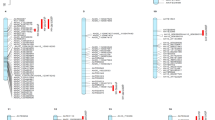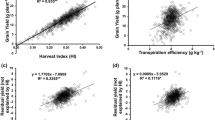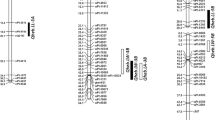Abstract
Low transpiration rates in pearl millet under fully irrigated conditions decrease plant water use at vegetative stage and then increase the water availability during grain filling and finally the terminal drought tolerance. Hundred and thirteen recombinant inbred lines developed from a cross between H77/833-2 and PRLT2/89-33 (terminal drought-sensitive × tolerant genotype) were evaluated to map transpiration rate (Tr, a proxy for canopy conductance), organ weights, leaf area and thickness and to study their interactions. Transpiration rate was increased by two H77/833-2 and two PRLT2/89-33 alleles on linkage group (LG) 2, whose importance depended on the vapor pressure deficit. The two H77/833-2 and one PRLT2/89-33 alleles co-mapped to a previously identified major terminal drought tolerance quantitative trait locus (QTL), although in a much smaller genetic interval. The other Tr allele from H77/833-2 also enhanced biomass dry weight and co-located with a formerly identified stover and tillering QTL. Leaf characteristics were linked to two loci on LG7. Plant water use was increased and decreased by different loci combinations for Tr, tillering and leaf characteristics, whose respective importance depended on the environmental conditions. Therefore, different alleles influence plant water use and have close interactions with one another and with the environment, so that different ideotypes for plant water use exist or could be designed from specific allele combinations conferring particular physiological characteristics for specific adaptation to a range of terminal drought conditions.





Similar content being viewed by others
References
Banziger M, Cooper M (2001) Breeding for low input conditions and consequences for participatory plant breeding examples from tropical maize and wheat. Euphytica 122(3):503–519
Bidinger FR, Hash CT (2004) Pearl millet. In: Nguyen HT, Blum A (eds) Physiology and biotechnology integration for plant breeding. New York, Marcel Dekker, pp 225–270
Bidinger FR, Mahalakshimi V, Durga Prasada Rao G (1987) Assessment of drought resistance in pearl millet [Pennisetum americanum (L.) Leeke]: II. Estimation of genotype response to stress. Aust J Agric Res 38:49–59
Bidinger FR, Nepolean T, Hash CT, Yadav RS, Howarth CJ (2007) Identification of QTLs for grain yield of pearl millet [Pennisetum glaucum (L.) R. Br.] in environments with variable moisture during grain filling. Crop Sci 47(3):969–980
Blum A, Mayer J, Golan G (1988) The effect of grain number (sink size) on source activity and its water-relations in wheat. J Exp Bot 39:106–114
CoSTAT, version 6.204 (2009) CoHort software, Monterey, CA, USA
Devi MJ, Sinclair TR, Vadez V (2010) Genotypic variation in peanut for transpiration response to vapor pressure deficit. Crop Sci 50:191–196
Fussell LK, Bidinger FR, Bieler P (1991) Crop physiology and breeding for drought tolerance: research and development. Field Crops Res 27:183–199
GenSTAT software (version 12) (2011) Clarendon Press, Oxford, UK
Gholipoor M, Vara Prasad PV, Mutava RN, Sinclair TR (2010) Genetic variability of transpiration response to vapour pressure deficit among sorghum genotypes. Field Crops Res 119(1):85–90
Hackett CA, Broadfoot LB (2003) Effects of genotyping errors, missing values and segregation distortion in molecular marker data on the construction of linkage maps. Heredity 90:33–38
Hammer GL (2006) Pathways to prosperity: breaking the yield barrier in sorghum. J Austr Inst Agric Sci Technol 19:16–22
Hammer GL, Butler D, Muchow RC, Meinke H (1996) Integrating physiological understanding and plant breeding via crop modelling and optimisation. In: Cooper M, Hammer GL (eds) Plant adaptation and crop improvement. CAB International, ICRISAT and IRRI, Wallingford, pp 419–441
Hash CT, Yadav RS, Cavan GP, Howarth CJ, Liu H, Xiaoquan Q, Sharma A, Kolesnikova-Allen MA, Bidinger FR, Witcombe JR (1999) Marker-assisted backcrossing to improve terminal drought tolerance in pearl millet. In: Ribaut J-M, Poland D (eds) Proceedings of a strategic planning workshop on molecular approaches for the genetic improvement of cereals for stable production in water-limited environments, June 21–25, CIMMIT, El Batan, Mexico, CIMMIT Mexico, D.F. Mexico, pp 114–119
Isobe S, Nakaya A, Tabata S (2007) Genotype matrix mapping. Searching for quantitative trait loci interactions in genetic variation in complex traits. DNA Res 14:217–225
Jones ES, Liu CJ, Gale MD, Hash CT, Withcombe JR (1995) Mapping quantitative trait loci for downy mildew resistance in pearl millet. Theor Appl Genet 91:448–456
Kholová J, Hash CT, Kakkera A, Kočová M, Vadez V (2010a) Constitutive water conserving mechanisms are correlated with the terminal drought tolerance of pearl millet [Pennisetum glaucum (L.) R. Br.]. J Exp Bot 61(2):369–377
Kholová J, Hash CT, Lava Kumar P, Yadav SR, Kočová M, Vadez V (2010b) Terminal drought-tolerant pearl millet [Pennisetum glaucum (L.) R. Br.] have high leaf ABA and limit transpiration at high vapor pressure deficit. J Exp Bot 61(5):1431–1440
Kholová J, Zindy P, Hash CT, Kočová M, Vadez V (2010c) Genotypes contrasting for terminal drought tolerance also contrast for the developmental pattern of water use in varying environmental conditions. In: Australian summer grain conference, 21–24. July, Gold Coast, Australia. 2010. Book of abstracts 7 (Peer-reviewed and accepted conference publication)
Kim HK, Luquet D, van Oosterom EJ, Dingkuhn M, Hammer GL (2010a) Regulation of tillering in sorghum: genetic effects. Ann Bot 106:69–78. doi:10.1093/aob/mcq080
Kim HK, van Oosterom EJ, Dingkuhn M, Luquet D, Hammer GL (2010b) Regulation of tillering in sorghum: environmental effects. Ann Bot 106:57–67. doi:10.1093/aob/mcq079
Liu CJ, Witcombe JR, Pittaway TS, Nash M, Hash CT, Busso CS, Gale MD (1994) An RFLP-based genetic map in pearl millet (Pennisetum glaucum). Theor Appl Genet 89:481–487
Ludlow MM, Muchow RC (1990) A critical evaluation of traits for improving crop yields in water-limited environments. Adv Agron 43:107–153
Mahalakshmi V, Bidinger FR, Raju DS (1987) Effect of timing of water deficit in pearl millet [Pennisetum americanum (L.) Leeke]. Field Crops Res 15(3–4):327–339
Masle J, Gilmore SR, Farquhar GD (2005) The ERECTA gene regulates plant transpiration efficiency in Arabidopsis. Nature 436:860–870
McKay JK, Richards JH, Nemali KS, Sen S, Mitchell-Olds T, Sandra Boles S, Stahl EA, Wayne T, Juenger TE (2008) Genetics of drought adaptation in Arabidopsis thaliana. II. QTL analysis of a new mapping population, KAS-1 X TSU-1. Evolution 62–12:3014–3026
Nepolean T (2002) Identification of QTLs for yield and its component traits, and downy mildew (Sclerospora graminicola [Sacc.] J. Schrot.) resistance in pearl millet [Pennisetum glaucum (L.) R. Br. PhD Thesis, Centre for plant breeding and genetics. Tamil Nadu Agricultural University, Coimbatore—641 003
Nepolean T, Blümmel A, BhaskerRaj AG, Rajaram V, Sentilvel S, Hash CT (2006) QTLs controlling yield and stover quality traits in pearl millet. eSAT Open Access J 2(1):4
Poncet V, Martel E, Allouis S, Devos KM, Lamy F, Sarr A, Robert T (2002) Comparative analysis of QTLs affecting domestication traits between two domesticated × wild pearl millet (Pennisetum glaucum L., Poaceae) crosses. Theor Appl Genet 104:965–975
Qi X, Pittaway TS, Lindup S, Liu H, Wateran E, Padi FK, Hash CT, Zhu J, Gale MD, Devos KM (2004) An integrated genetic map and new set of simple sequence repeat markers for pearl millet, Pennisetum glaucum. Theor Appl Genet 109:1485–1493
Ravi K, Vadez V, Isobe S, Mir RR, Guo Y, Nigam SN, Gowda MVC, Radhakrishnan T, Bertioli DJ, Knapp SJ, Varshney RK (2010) Identification of several small main-effect QTLs and a large number of epistatic QTLs for drought tolerance related traits in groundnut (Arachis hypogea L.). Theor Appl Genet 122:1119–1132. doi:10.1007/s00122-010-1517-0
Reymond M, Muller B, Leonardi A, Charcosset A, Tardieu F (2003) Combining quantitative trait loci analysis and an ecophysiological model to analyze the genetic variability of the responses of maize leaf growth to temperature and water deficit. Plant Physiol 131:664–675
R software (version 2.11.1) R Development Core Team (2007) R: a language and environment for statistical computing. R Foundation for Statistical Computing, Vienna. http://www.R-project.org://www.R-project.org
SAS, version 9.2 (2009) SAS Institute Inc. Cary, NC, USA
Semagn K, Bjornstad A, Ndjiondjop MN (2006) Principles, requirements and prospects of genetic mapping in plants. Afr J of Biotechnol 5:2569–2587
Serraj R, Hash CT, Rizvi SMH, Sharma A, Yadav RS, Bidinger FR (2005) Recent advances in marker-assisted selection for drought tolerance in pearl millet. Plant Prod Sci 8:334–337
Sinclair TR, Purcell LC, Sneller CH (2004) Crop transformation and the challenge to increase yield potential. Trends Plant Sci 9:70–75
Stegmeier WD, Andrews DJ, Rai KN, Hash CT (1998) Pearl millet parental lines 843A and 843B. International Sorghum Millet Newslett 39:129–130
Supriya A, Senthilvel S, Nepolean T, Eshwar K, Rajaram V, Shaw R, Hash CT, Kilian A, Yadav RC, Narasu ML (2011) Development of a molecular linkage map of pearl millet integrating DArT and SSR markers. Theor Appl Genet 123:239–250
Tardieu F, Reymond M, Hamard P, Granier C, Muller B (2000) Spatial distributions of expansion rate, cell division rate and cell size in maize leaves: a synthesis of effect of soil water status, evaporative demand and temperature. J Exp Bot 51:1505–1514
Tsuge T, Tsukaya H, Uchimiya H (1996) Two independent and polarized processes of cell elongation regulate leaf blade expansion in Arabidopsis thaliana (L.) Heynh. Development 122:1589–1600
Tsukaya H (2005) Leaf shape: genetic controls and environmental factors. Int J of Dev Biol 49:547–555
Tuberosa R, Salvi S (2007) Genomics approaches to improve drought tolerance in crops. Trends Plant Sci 11:412–415
Utz HF, Melchinger AE (1996) PLABQTL: a program for composite interval mapping of QTL. Inst. Plant Breed., Seed Sci., Pop. Genet., Univ. of Hohenheim, Stuttgart, Germany
Vadez V, Warkentin T, Asseng S, Ratnakumar P, Rao KPC, Gaur PM, Munier-Jolain N, Larmure A, Voisin AS, Sharma HC, Krishnamurthy L, Zaman-Allah M (2012) Adapting grain legumes to climatic changes: major issues to tackle. Agron Sust Dev 32:31–44
Yadav RS, Hash CT, Bidinger FR, Cavan GP, Howart CJ (2002) Quantitative trait loci associated with traits determining grain and stover yield in pearl millet under terminad drought-stress conditions. Theor Appl Genet 104:67–83
Yadav RS, Bidinger FR, Hash CT, Yadav YP, Yadav OP, Bhatnagar SK, Howarth CJ (2003) Mapping and characterization of QTL × E interactions for traits determining grain and stover yield in pearl millet. Theor Appl Genet 106:512–520
Yadav RS, Hash CT, Bidinger FR, Devos KM, Howarth CJ (2004) Genomic regions associated with grain yield and aspects of post-flowering drought tolerance in pearl millet across stress environments and testers background. Euphytica 136:265–277
Zaman-Allah M, Jenkinson DM, Vadez V (2011) A conservative pattern of water use, rather than deep or profuse rooting, is critical for the terminal drought tolerance of chickpea. J Exp Bot 62:4239–4252
Acknowledgments
The senior author was supported by a grant from DFID-BBSRC, Research Contract BB/F004133/1.
Author information
Authors and Affiliations
Corresponding author
Electronic supplementary material
Below is the link to the electronic supplementary material.
Rights and permissions
About this article
Cite this article
Kholová, J., Nepolean, T., Tom Hash, C. et al. Water saving traits co-map with a major terminal drought tolerance quantitative trait locus in pearl millet [Pennisetum glaucum (L.) R. Br.]. Mol Breeding 30, 1337–1353 (2012). https://doi.org/10.1007/s11032-012-9720-0
Received:
Accepted:
Published:
Issue Date:
DOI: https://doi.org/10.1007/s11032-012-9720-0




